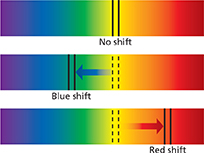26.5 The Expanding Universe
Reading Focus
Key Concepts
 How do astronomers know that the universe is expanding?
How do astronomers know that the universe is expanding? What is the big bang theory, and what evidence supports it?
What is the big bang theory, and what evidence supports it? How can dark matter be detected?
How can dark matter be detected?
Vocabulary
red shift
Hubble's Law
big bang theory
dark matter
Reading Strategy
Previewing Before reading, examine Figure 26 and write at least two questions to help you understand the information in it. As you read, write answers to your questions.
Questions on the Evolution of the Universe
a. ________
 ________
________b. ________
 ________
________
Have you ever wanted to use a time machine to travel back in time? Telescopes are like time machines because they show what happened in other parts of the universe in the distant past. When you observe a star that is ten light-years away, you are seeing the star as it was ten years ago. This is because light took ten years to travel from the star to Earth. Images of galaxies that are billions of light-years away show how these galaxies looked billions of years ago.
Figure 24 Absorption lines of a galaxy shift toward the blue end of the spectrum when it moves toward Earth. The lines shift to the red end of the spectrum when a galaxy moves away from Earth.  Inferring How would the spectrum of a galaxy that is slowly moving away from Earth compare to one that is moving away much more quickly?
Inferring How would the spectrum of a galaxy that is slowly moving away from Earth compare to one that is moving away much more quickly?

Hubble's Law
Recall from physics that as a sound or light source moves toward or away from an observer, its frequency and wavelength appear to change. This apparent change in frequency and wavelength is known as the Doppler effect. The Doppler effect can be used to determine how fast stars or galaxies are approaching or moving away from Earth. When a star or galaxy is approaching Earth, the lines in its spectrum are shifted toward the shorter (bluer) wavelengths, as shown in Figure 24. When the star or galaxy is moving away, the lines in its spectrum shift toward the longer (redder) wavelengths. The larger the observed shift, the greater is the speed of this movement.
In the mid-1920s, the American astronomer Edwin Hubble studied many galaxies at different distances from Earth. In 1929, Hubble announced his discovery: the light from most galaxies undergoes a red shift—that is, their light is shifted toward the red wavelengths. This red shift showed that, remarkably, nearly all galaxies are getting farther away from Earth.




